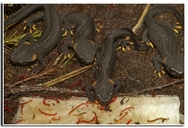|
Description
Tylototriton taliangensis measures 186-220 mm in total length for males, 194-230 mm for females. Head and body combined are similar in length to the tail. Head is somewhat flat, and of equal length and width. No labial folds. Snout is relatively raised and rectangular in shape. Vomerine teeth rows are relatively long, two rows are in / orientation and meet near the inner nasal bone. Body robust, with a flattened venter. Dorsal skin surface is very rough. An obvious red glandular protrusion is found on each side of the head posterior to the eye. Jugular fold apparent. Legs are relatively long; toes overlap when limbs are adpressed to the flank. There are four unwebbed toes on each forelimb and five unwebbed toes on each hindlimb. A noticeable but short and thin tail fin fold is present. The tail is robust and wide starting from the anus but becomes considerably thinner and weaker towards the tip. Tip of the tail is sharp.
The body and tail are black, with conspicuous red markings present on the glandular protrusion, the tips of toes, and the lower tail fin fold. The venter has a lighter color than the rest of the body. Distribution and Habitat
Country distribution from AmphibiaWeb's database: China
This species is endemic to mountains of Sichuan province in China, at elevations from 1390-3000 m above sea level. It is mostly terrestrial and is found in the shrubs and bushes.Life History, Abundance, Activity, and Special Behaviors
During the day, Tylototriton taliangensis hides in rock tunnels, holes, and in the covers of bushes. It comes out at night to prey on insects and other little animals.
During mating season from May to June, Tylototriton taliangensis seeks wetlands and marshes. The female lays 250-280 unbound, individual eggs, usually near aquatic vegetation or at the bottom of the water body. Eggs are 5.5 mm in diameter.
Trends and Threats
This species is declining due to collection for medicinal uses. It is considered a Class II protected species under China's wild animal protection law. Possible reasons for amphibian decline General habitat alteration and loss
Habitat modification from deforestation, or logging related activities
Intensified agriculture or grazing
Intentional mortality (over-harvesting, pet trade or collecting)
References
Fei, L. and Ye, C. (2001). The Colour Handbook of the Amphibians of Sichuan. Chinese Forestry Publishing House, Beijing.
Originally submitted by: Michael Li (first posted 2000-02-07)
Edited by: Kellie Whittaker (2008-11-26)Species Account Citation: AmphibiaWeb 2008 Tylototriton taliangensis: Taliang Knobby Newt <https://amphibiaweb.org/species/4308> University of California, Berkeley, CA, USA. Accessed Jun 1, 2025.
Feedback or comments about this page.
Citation: AmphibiaWeb. 2025. <https://amphibiaweb.org> University of California, Berkeley, CA, USA. Accessed 1 Jun 2025.
AmphibiaWeb's policy on data use.
|




 Raffaëlli Account
Raffaëlli Account Map of Life
Map of Life